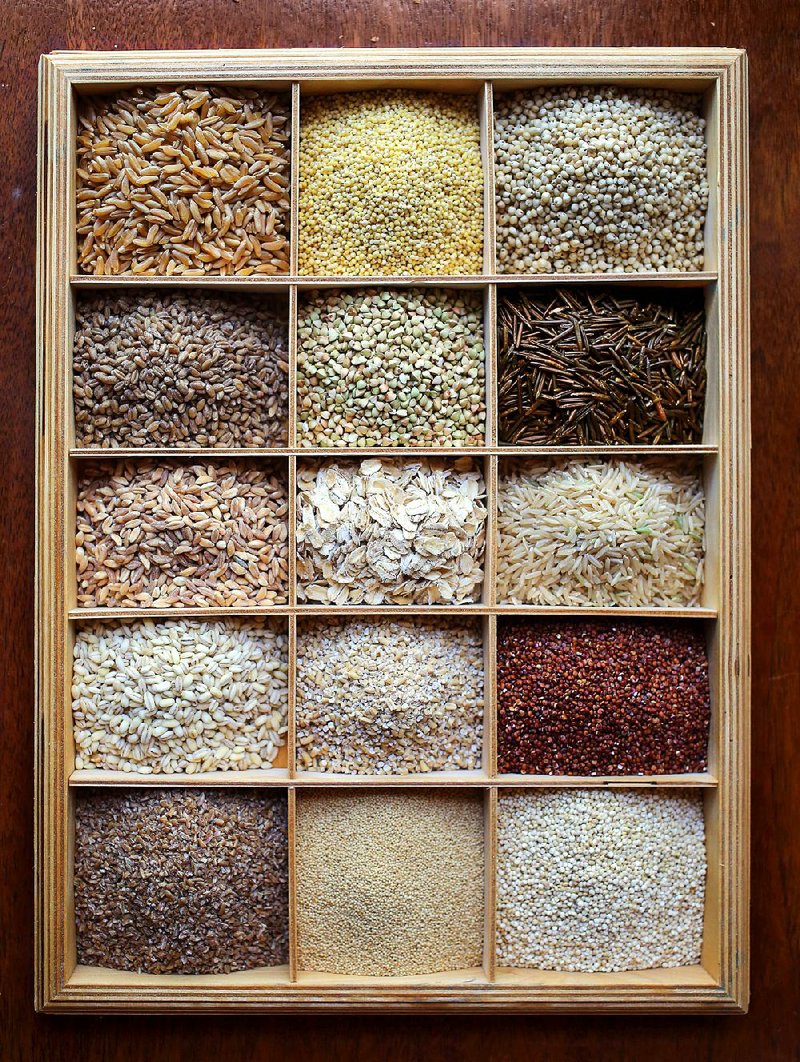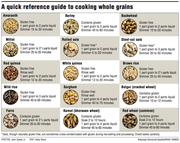This story is part one of a two-part series about cooking with whole grains. Next week will feature recipes that star or incorporate whole grains.
The current dietary guidelines -- a government publication intended for policymakers and health professionals, not individuals, to help Americans eat a more nutritious diet -- suggest we should be eating a varied diet rich in fruits and vegetables, whole grains, lean proteins and low-fat dairy with limited saturated fat, sugar and salt. (To read the mammoth document yourself, visit health.gov/dietaryguidelines/2015/guidelines.)
Fruits and vegetables are easy (in theory), as are lean proteins and low-fat dairy. Most of us are familiar with these things. If you're preparing your own meals, rather than letting a restaurant or food manufacturer do it for you, sugar and salt are obvious. Saturated fat (found in meat and dairy products such as cheese and butter) is easily avoided by reading nutrition labels and sticking with the lean protein and low-fat dairy suggestions. But whole grains? They may be a bit of a mystery.
When food people talk grains they are generally referring to cereal grains.
A cereal grain is the fruit or seed of a grass plant.
A whole grain is defined as one that has its bran, endosperm and germ intact. The grains can be crushed, cracked, rolled or even par-cooked. Many grains have tough, inedible husks or hulls that must be removed. Most grains that have had their hulls removed (hulled) are considered whole; pearled grains have been polished to remove the hull and bran, so they are not considered whole.
Examples of familiar whole grains include corn, brown rice, oats, barley and wheat berries. Lesser known whole grains include millet, Kamut, rye and sorghum.
Foods that we treat as cereal grains but are botanically different include buckwheat, amaranth and quinoa. Because these plants are not grasses, they are not considered true grains but they have similar nutritional profiles and we eat their seeds in much the same manner. They are sometimes called pseudocereals.
Why whole grains? The bulk of a grain's nutrients (and flavor and texture) can be found in the bran and germ. White flour, white rice, pearled barley and other refined grain products have had most or all of the bran and germ layers removed, stripping the grains of their fiber, B vitamins, magnesium and other nutrients. These foods are often "enriched" with added niacin, riboflavin, thiamine and iron.
Several cookbooks and cooking websites tout the added nutritional benefits of soaking grains prior to cooking. But we found no scientific evidence to back this claim. However, soaking does help the grains cook faster and some find soaked grains are easier on the digestive system.
Sprouted grains, on the other hand, do contain marginally higher concentrations of some vitamins and minerals, according to the Whole Grains Council, a nonprofit consumer advocacy group, and the University of California Davis Center for Health and Nutrition Research. Because conditions must be just so and sprouts are a common source of food-borne illness, we do not recommend sprouting grains at home.
Whole or ground (flour) versions of the following grains can be found at well-stocked supermarkets and health food stores. Many are available in bulk.
AMARANTH
Amaranth, with its tiny -- think grain-of-sand tiny -- seeds, is native to the Americas and was cultivated by the Aztecs. The plant is often regarded as a weed -- pigweed, to be specific -- but its seeds and leaves are packed with nutrients. The flavor is sweet and peppery. This versatile grain can be ground into flour, used to thicken soups or even "popped" in a dry skillet like popcorn. A 1-cup serving contains about 250 calories, 9 g protein, 4 g fat, 46 g carbohydrate, 5 g fiber, 116 mg calcium and 332 mg potassium.
BARLEY
Originating in Africa and Southeast Asia, barley is most
commonly used as an ingredient in beer, although it has a well-known affinity for soup. It is chewy and slightly nutty. Pearl, or polished, barley, available at most grocery stores, has been polished numerous times to remove the inedible hull and some of its bran. Less-common hulled barley, though it takes longer to cook, retains its bran and has more flavor and contains more nutrients. A 1-cup serving of pearled barley contains about 200 calories, 3 g protein, less than 1 g fat, 44 g carbohydrate, 6 g fiber and 146 mg potassium.
BROWN RICE
Rice is the staple starch for more than half the world's population. Its origins can be traced to India and China, and though it grows best in tropical climates, the United States -- with Arkansas leading the bunch -- grows roughly 85 percent of the rice Americans eat. Though it takes twice as long to cook as its white counterpart, brown rice has two to three times the fiber. It also contains more phosphorus and potassium. It has a pleasingly chewy texture and nutty flavor. A 1-cup serving of brown rice contains about 250 calories, 5 g protein, 2 g fat, 52 g carbohydrate, 3 g fiber, 208 mg phosphorus and 174 mg potassium.
BUCKWHEAT
This pseudocereal has an earthy flavor and hearty, yet fluffy texture when cooked. It is commonly ground into flour for pancakes. Toasted buckwheat is known as kasha. Buckwheat is native to Russia and the preferred flour for blini. A 1-cup serving of buckwheat groats contains about 155 calories, 6 g protein, 1 g fat, 33 g carbohydrate, 5 g fiber, 118 mg phosphorus and 148 mg potassium.
BULGUR
Bulgur is made up of whole grains of wheat that have been steamed, then dried and crushed into grits. It is perhaps most well-known as the star ingredient in the Middle Eastern favorite tabbouleh. Cracked wheat is a similar product, but it is not steamed before crushing. A 1-cup serving contains about 150 calories, 5 g protein, less than 1 g fat, 33 g carbohydrate and 8 g fiber.
FARRO
Also known as emmer, this ancient relative of modern wheat has a hearty, chewy texture and rich, nutty flavor. Farro was cultivated by the Egyptians as long as 20,000 years ago. It was a dietary staple in ancient Rome and is popular in Italy today. A 1-cup serving has about 200 calories, 8 g protein, 2 g fat, 52 mg carbohydrate and 8 g fiber.
KAMUT
The brand name of khorasan wheat, Kamut is an ancient variety that can be traced to Egypt and is more easily digested than regular wheat by some people. Kamut berries have a similar flavor and texture to white or red wheat berries, yet they are about twice as large and contain 20 percent to 40 percent more protein than common wheat. It has a sweet, buttery flavor. A 1-cup serving contains about 225 calories, 10 g protein, 1 g fat, 47 g carbohydrate, 7 g fiber, 253 mg phosphorus and 282 mg potassium.
MILLET
This tiny, golden grain may be familiar to most as bird seed, but don't dismiss it. The African grain has a pleasant flavor and a distinctive texture. When cooked, the seedlike grains do not cook uniformly, providing contrast with buttery smooth grains and slightly crunchy ones. The versatile grain works well in sweet or savory preparations. A 1-cup serving contains about 200 calories, 6 g protein, 2 g fat, 42 g carbohydrate, 174 mg phosphorus and 108 mg potassium.
OATS
This whole grain is probably the most familiar to everyone. Whether rolled, instant, Scottish or steel-cut, all oats are considered whole grain. Rolled and quick-cooking oats have a creamy texture, while Scottish oatmeal and steel-cut oats are chewier. Those with gluten intolerance should read labels carefully. Oats are naturally gluten-free, but are often harvested or processed with the same equipment used for wheat and can contain traces of gluten. Oats are widely grown in North America and Europe, but may have originated in the Near East. Oats are an excellent source of beta glucans, a specific type of fiber that helps reduce cholesterol. A 1-cup serving contains about 160 calories, 6 g protein, 4 g fat, 4 g fiber, 180 mg phosphorus and 164 mg potassium.
QUINOA
Cultivated centuries ago by the Incas, these tiny beige, red or dark brown seeds have a nutty flavor and a toothsome bite. Quinoa is a good source of protein, iron, potassium, magnesium and lysine. It cooks quickly and fluffs up, making it an ideal substitute for rice. It is good in soups, salads, stuffings or on its own. A 1-cup serving contains about 225 calories, 8 g protein, 4 g fat, 5 g fiber, 118 mg magnesium, 281 mg phosphorus and 318 mg potassium.
SORGHUM
The same plant that gives us sorghum molasses also gives us sorghum grains. Sorghum is native to Africa and India, but is widely planted in the United States primarily for its sweet syrup, as animal fodder and for making ethanol. Arkansas ranks fifth in U.S. sorghum production. The grains look similar to Israeli couscous, but with a tiny black "eye." It has a mild flavor with a hearty, if slightly gritty, texture. The small grains can be popped like popcorn. A 2/3-cup serving of sorghum grains has about 180 calories, 5 g protein, 1 g fat, 39 g carbohydrate and 8 g fiber.
SPELT
A cousin of common wheat, spelt has been cultivated for at least 9,000 years, originating in southeastern Europe and the Middle East. Its large, dense berries are a tasty addition to soups and casseroles. Like Kamut, it is more easily digested than common wheat. Spelt is sometimes labeled farro, but the two are not interchangeable. It has a mellow, nutty flavor. A 1-cup serving contains about 250 calories, 11 g protein, 2 g fat, 51 g carbohydrate, 95 mg magnesium, 291 mg phosphorus, 277 mg potassium and 8 g fiber.
WILD RICE
The only grain native to North America, wild rice is not considered a true rice. It is a marsh grass native to the northern Great Lakes area. It is often sold blended with white and brown rice. With a chewy texture and distinctive flavor, wild rice is delicious in pilafs and stuffings. A 1-cup serving has about 160 calories, 1 g fat, 7 g protein, 35 g carbohydrate and 3 g fiber.
Sources: The Whole Grains Council, U.S. Department of Agriculture National Nutrient Database for Standard Reference, Bob's Red Mill, Sorghum Checkoff, The Deluxe Food Lover's Companion by Ron Herbst and Sharon Tyler Herbst, USA Rice Federation.
Food on 04/27/2016
*CORRECTION: Barley contains gluten. A quick reference guide to cooking whole grains chart that accompanied the story Grains of goodness incorrectly listed the gluten content of barley. The chart also failed to note that oats, though naturally gluten-free, are sometimes cross-contaminated with gluten from other grains during harvesting and processing.

